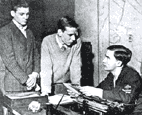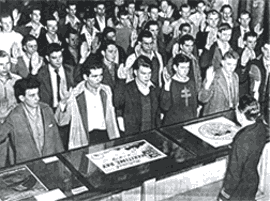U.S. Maritime Service Enrolling Office: Thousands of men pass through the Service's Enrolling Offices daily on their way to Training Stations.
MAST Magazine November 1944
Apprentice Seaman's first contact with the Maritime Service is with fast-talking "Answer Men."This is the story of the Answer Man -- more generally and formally known in the Maritime Service as the enrolling officer.
He is the embryo seaman's first contact. Before any young man can go down to the sea, he must first go down to the enrolling office. On the way this first brush with the Maritime Service strikes the young man's fancy often depends whether the Service has gained another trainee or has lost one.
It hinges largely on the answers. And such questions! You can spend days with an enrolling officer throwing every conceivable query at him, but always he'll reply, "I've heard that one before, too."
Two prospective trainees getting pointers
on the U.S. Maritime Service from Yeoman 2nd classThe two most common questions asked are: "How soon can I go to sea?" "What's the shortest amount of training I can get by with?"
They want to know how much money they'll make while in training and how much they can expect when they go to sea. They're anxious to find out if any allotments go to their families or how they can make financial provisions for them. "How often do I have to ship out?" "How long can I stay ashore between trips?"
Some of the applicants are interested in knowing what opportunities are available to them for improving themselves in the Maritime Service and the Merchant Marine and how soon it will be possible for them to get commissions. They ask about the quality of the food, the quantity and whether it is necessary to provide their own clothes or buy uniforms.
Parents frequently come in with their sons, particularly the 'teen-age' applicants. They query regarding religious facilities available and where their sons can get counsel if they have personal problems. They ask if they can visit their sons at the training station. The boys inquire if sweethearts can call on them.
They want to know the provisions for entertainment while in training and what sort of athletic programs are provided. Can they get servicemen's rates for shows and furlough rates on trains?
Many of the applicants are found to be interested in gunnery and want to know what types of courses are offered at the training stations and also what their duties are with respect to guns when they go to sea.
It is not too much of a rarity, in the New York Enrolling Office at least, to get calls from women asking if there is any way in which they can go to sea in some capacity.
In filling out applications, two of the questions seem to give the younger boys the most trouble. A youngster was heard to ask his neighbor: "What is this 'speech impediment'?" Another troublemaker is surname.
The New York Enrolling Office at 45 Broadway is the largest in the service, and its problems and performances are typical of all the offices scattered strategically throughout the nation.
During the course of an average day, about 300 men of all ages and types approach one of the information desks of the New York Office with questions. Not so long ago when the doors of the Maritime Service were open to the 16- to 17 1/2 year-old group, this office was reported to have handled as many as 800 to 900 in a single day.
In the two years that have elapsed since the operation of the office was taken over by the Maritime Service from the U. S. Coast Guard, about 21,000 men have been actually enrolled in all types of training from the New York office alone. Included in this group are apprentice seamen, officers, upgrading men, safety seamen. This office is not to be confused with the New York Regional Enrolling Office which embraces, in addition to New York City, Buffalo, N. Y., and Newark, N. J. From September 1943 to the same month this year [1944] the New York office handled 12,040 men and the regional office took care of 15,318.
The New York Enrolling Office occupies the entire ground floor of a nine-story office building in the heart of lower Broadway. The building, now taken over entirely by the War Shipping Administration, was formerly used by the North German Lloyd Steamship Lines.
As you walk into the enrolling office, with its marble walls and pillars, you are struck by the resemblance to the waiting room of a railroad station. Men stand in queues before the information desks, or are waiting to fill out their applications or to be examined. Others are standing around in small groups waiting to be interviewed. There is a quiet buzz and bustle throughout the room.
Four yeomen devote practically all of their time to nothing else but answering questions. When there is an unusual rush of applicants, others pitch in to help out.
How is an information clerk trained? Well, there is no special course for these men, but every enlisted man who is assigned to administrative duty at the New York Enrolling Office spends his first month working with one of the experienced men at one of the counters. Here he learns all the answers. It is not the purpose of this training to make every man a regular interviewer, hut it has been found to be the best way to familiarize a new man with the operations of the office. Furthermore, during an emergency it may be the duty of any enlisted man to step in and be able to answer the questions.
When the prospective trainee comes into the enrolling office he usually first approaches one of the information desks where he is given whatever preliminary data he desires on the service. According to existing regulations, the applicant must be between 17 and 50 1/2 years old and must not have received a pre-induction draft notice.
If the applicant is found to be able to meet the age requirements he is given a chit which admits him to the medical department for a screen test to determine height and weight only. The minimum requirement is five feet four inches and 130 pounds. If he passes, he returns to the information desks and fills out application forms. On this application he must give his correct home address.
If the applicant falls within the 'teen-age group,' the enrolling office sends consent forms by mail to his parents or legal guardian to preclude forgery. These forms must be signed, notarized and returned by mail. There have been cases where youngsters have attempted forgeries in order to get into the service.
When all these preliminaries have been accomplished, the applicant is called as soon as possible for his physical examination. At this time, he brings with him proof of birth. With all his papers in order and having passed his physical examination, he is sworn into the Maritime Service and placed on an inactive status, subject to call within twenty-four hours.
The New York Enrolling Office just before they leave for the Sheepshead Bay
Training Station for their Preliminary Training. Lieutenant administers the Oath.
Poster in center of table tells of National Maritime Day, May 22.
Poster on left shows Mussolini saying, "We consider peace a catastrophe for
human civilization." What do YOU say, AMERICANS?
On the right is the U.S. Maritime Service Seal.The New York Enrolling Office tries to call men within three weeks after they have been sworn in. The number of men enrolled at any one time from all sections of the country depends entirely upon quotas issued from Washington, which are governed by the current shipping needs. These quotas fluctuate markedly from time to time.
No man is ever given any guarantee upon entering the Service that he will be given the type of training he desires. Every enrollee signs as an apprentice seaman, undergoes preliminary training and such advanced training as may be chosen by a classification officer on the basis of classification and selection tests given during the training period. Enrolling officers are under orders to make no promises whatever to candidates.
List of U.S. Maritime Service Enrolling Offices, 1944
3/30/01

